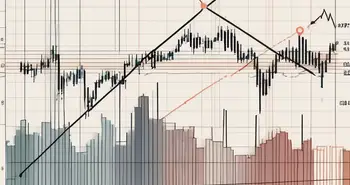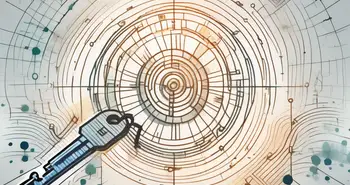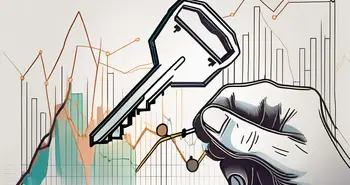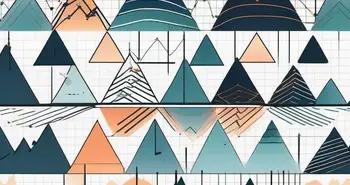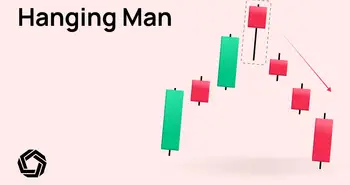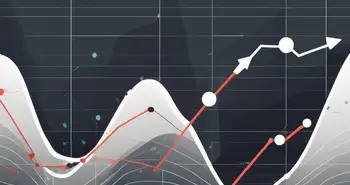An Introduction to Bilateral Chart Patterns

Bilateral chart patterns are a powerful tool in the world of trading. These patterns provide valuable insights into market behavior, helping traders make informed decisions and maximize their profits. In this article, I will guide you through the intricacies of bilateral chart patterns, from understanding their significance to effectively utilizing them in your trading strategy.
Understanding Bilateral Chart Patterns
Defining Bilateral Chart Patterns
Before we delve deeper, let's define what bilateral chart patterns actually are. Simply put, bilateral chart patterns are formations on price charts that indicate a temporary consolidation period in the market. During this consolidation, traders observe a pause in the trend, resulting in a symmetrical pattern that resembles a triangle or a rectangle.
It's important to note that bilateral chart patterns are not limited to just triangles and rectangles. Other common bilateral patterns include flags, pennants, and rectangles. Flags and pennants are short-term continuation patterns that signal a brief pause in the prevailing trend before the continuation of the prior move. On the other hand, rectangles represent a period of consolidation where the price moves within a horizontal range, indicating indecision in the market.
The Importance of Bilateral Chart Patterns in Trading
Bilateral chart patterns are critical to traders as they provide vital information about market sentiment and potential future price movement. By recognizing these patterns, traders can anticipate breakouts or breakdowns, enabling them to enter or exit positions at opportune moments.
For example, the symmetrical triangle pattern, a common bilateral chart pattern, indicates that the market is in a state of indecision. As the pattern narrows towards the apex, the tension builds, and the eventual breakout can often lead to a significant price move. By identifying this pattern, traders can enter positions just before the breakout, capturing substantial profits.
Another important bilateral chart pattern is the rectangle, which signifies a period of consolidation where the price oscillates between a defined support and resistance level. Traders often look for a breakout above or below the rectangle to confirm a new trend direction. This breakout can signal a strong buying or selling opportunity, depending on the direction of the price movement.
The Anatomy of Bilateral Chart Patterns
Key Components of Bilateral Chart Patterns
Now that we understand the importance of bilateral chart patterns, let's explore their components. The key elements of bilateral chart patterns consist of the support and resistance levels, trendline boundaries, and the apex.
The support and resistance levels define the upper and lower boundaries of the pattern. Traders look for price breakouts or breakdowns to confirm a change in trend direction.
Trendline boundaries connect the highs and lows of the price movement within the pattern. These trendlines help traders identify potential entry and exit points.
The apex, where the trendlines converge, represents the point of maximum tension and signals an imminent breakout or breakdown.
Understanding these components is crucial for traders looking to capitalize on bilateral chart patterns. The support and resistance levels act as critical zones where price action is likely to react, providing valuable insights into market sentiment. By analyzing how price interacts with these levels, traders can make informed decisions about potential entry and exit points.
Moreover, trendline boundaries offer visual cues about the strength of the prevailing trend. A well-defined trendline can serve as a guide for traders, helping them stay on the right side of the market. Recognizing the significance of trendlines in bilateral chart patterns can enhance a trader's ability to anticipate price movements accurately.
Recognizing Common Bilateral Chart Patterns
Several common bilateral chart patterns are worth noting, such as the symmetrical triangle, ascending triangle, descending triangle, and rectangle pattern. Each pattern has distinct characteristics that traders must learn to identify accurately.
For instance, the symmetrical triangle pattern usually signals a continuation of the existing trend, while the rectangle pattern suggests a temporary consolidation before a potential breakout or breakdown.
Being able to recognize these patterns in real-time can provide traders with a competitive edge in the market. By understanding the nuances of each pattern and their implications for price action, traders can make well-informed decisions that align with their trading strategies and risk tolerance levels.
The Psychology Behind Bilateral Chart Patterns
Trader Behavior and Bilateral Chart Patterns
Understanding human psychology is crucial when analyzing bilateral chart patterns. These patterns reflect the psychology of market participants and their indecision during the consolidation phase. When traders recognize this indecision, they can capitalize on the subsequent breakout or breakdown.
For instance, during a symmetrical triangle pattern, traders are unsure about the market's next move, leading to tighter price ranges and reduced trading volume. Nevertheless, as the pattern nears its apex, traders start gaining more clarity, and once the breakout occurs, excitement and increased trading volume drive the price significantly.
Market Sentiment and Bilateral Chart Patterns
Bilateral chart patterns also provide insights into market sentiment, which refers to the overall attitude and emotions of traders. By studying the sentiment reflected in these patterns, traders can anticipate market movements and position themselves accordingly.
For example, a descending triangle pattern usually indicates bearish sentiment, as sellers are gaining control and pushing the price downward. Recognizing this sentiment can help traders take short positions, profiting from the anticipated downward move.
Strategies for Trading Bilateral Chart Patterns
Timing Your Trades with Bilateral Chart Patterns
Timing is key when trading bilateral chart patterns. By waiting for confirmation of a breakout or breakdown, traders can minimize risk and increase the probability of a successful trade. Confirmation typically occurs when price action decisively breaks above or below the pattern's boundaries, accompanied by an increase in trading volume.
However, it's important to exercise caution and not be too hasty. False breakouts can occur, leading to losses. Therefore, combining chart patterns with other technical indicators or price analysis techniques can help validate the breakout signals.
Risk Management in Bilateral Chart Pattern Trading
Effective risk management is vital in any trading strategy, including bilateral chart pattern trading. Traders must define their risk tolerance and set appropriate stop-loss levels to limit potential losses.
Furthermore, it's essential to diversify your portfolio and not rely solely on bilateral chart patterns. Combining different trading strategies and assets can help spread risk and increase the overall profitability of your trades.
The Limitations of Bilateral Chart Patterns
Potential Pitfalls of Relying on Bilateral Chart Patterns
While bilateral chart patterns offer valuable insights, it's important to acknowledge their limitations. One common pitfall is the occurrence of false breakouts or breakdowns. These occur when the price briefly breaches the pattern's boundaries but quickly reverses, trapping unsuspecting traders.
To mitigate this risk, experienced traders often wait for a candlestick close beyond the pattern's boundaries to confirm a valid breakout or breakdown.
Overcoming Challenges in Bilateral Chart Pattern Analysis
Analyzing bilateral chart patterns can sometimes be subjective and open to interpretation. Traders may have differing opinions on the pattern's significance or the appropriate entry and exit points. To overcome this challenge, it's essential to continuously refine your analysis skills by studying historical chart patterns and incorporating feedback from fellow traders.
Unlocking the secrets of bilateral chart patterns can significantly enhance your trading prowess. By recognizing these patterns, understanding trader behavior and market sentiment, and implementing effective trading strategies, you can gain a competitive edge in the market.
Remember, practice makes perfect. As an experienced trader, I advise you to dedicate ample time to chart analysis and explore various bilateral chart pattern examples. Consider joining trading communities or engaging in mentorship programs to further refine your skills.
FAQ – Frequently Asked Questions
What are bilateral chart patterns?
Bilateral chart patterns are formations on price charts that indicate a temporary consolidation period in the market. These patterns resemble triangles or rectangles and provide insights into market sentiment and future price movements.
Why are bilateral chart patterns important in trading?
Bilateral chart patterns are crucial as they help traders anticipate breakouts or breakdowns, enabling them to enter or exit positions at opportune moments. These patterns provide valuable information about market sentiment and potential future price movement.
How do I recognize bilateral chart patterns?
Common bilateral chart patterns include the symmetrical triangle, ascending triangle, descending triangle, and rectangle pattern. By studying these patterns' characteristics, such as support and resistance levels and trendline boundaries, traders can accurately identify them.
Should I only rely on bilateral chart patterns for trading?
No, it's important not to rely solely on bilateral chart patterns for trading. Traders should combine different trading strategies and assets to spread risk and increase profitability. Additionally, it is recommended to use other technical indicators or price analysis techniques to validate breakout signals.
How can I overcome the challenges in analyzing bilateral chart patterns?
Analyzing bilateral chart patterns can be subjective and open to interpretation. To overcome this challenge, continuously refine your analysis skills by studying historical chart patterns, seeking feedback from fellow traders, and practicing with different examples.
Unlock the secrets of bilateral chart patterns, and you'll find yourself equipped with a powerful tool to navigate the volatile world of trading. Happy trading!
Ready to put your knowledge of bilateral chart patterns to the test on a platform that's as innovative as your trading strategy? Look no further than Morpher, the revolutionary trading platform that's changing the game with zero fees, infinite liquidity, and the ability to trade a vast array of assets. Whether you're looking to invest in fractional shares or take advantage of 10x leverage, Morpher offers a unique trading experience built on the Ethereum Blockchain. Sign up now and experience the future of trading with your free sign-up bonus. Sign Up and Get Your Free Sign Up Bonus and start trading the way you've always wanted to.

Disclaimer: All investments involve risk, and the past performance of a security, industry, sector, market, financial product, trading strategy, or individual’s trading does not guarantee future results or returns. Investors are fully responsible for any investment decisions they make. Such decisions should be based solely on an evaluation of their financial circumstances, investment objectives, risk tolerance, and liquidity needs. This post does not constitute investment advice.

Painless trading for everyone
Hundreds of markets all in one place - Apple, Bitcoin, Gold, Watches, NFTs, Sneakers and so much more.

Painless trading for everyone
Hundreds of markets all in one place - Apple, Bitcoin, Gold, Watches, NFTs, Sneakers and so much more.

